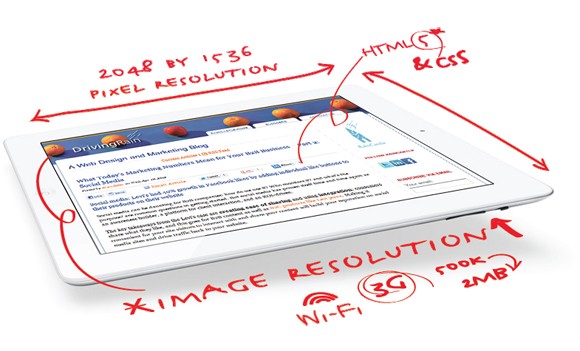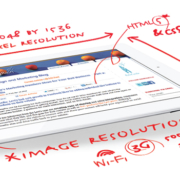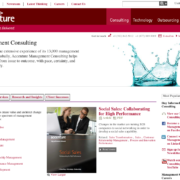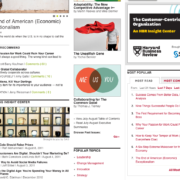What the New iPad Resolution Means for Your Website
 A couple of years ago it became quickly evident how ubiquitous the iPad had become amongst our C-level and VP clients. I recall making a critical first website design presentation to a new client only to find the CEO disconcertingly playing on his iPad while I was presenting. After a few minutes of this, the CEO looked up with a grin and showed us his screen on which was our website design in perfect proportion with great resolution. He was quite pleased, and it confirmed to us that the device criteria on which we tested our work had officially expanded.
A couple of years ago it became quickly evident how ubiquitous the iPad had become amongst our C-level and VP clients. I recall making a critical first website design presentation to a new client only to find the CEO disconcertingly playing on his iPad while I was presenting. After a few minutes of this, the CEO looked up with a grin and showed us his screen on which was our website design in perfect proportion with great resolution. He was quite pleased, and it confirmed to us that the device criteria on which we tested our work had officially expanded.


 As the mobile channel advances toward its tipping point, we are all learning best practices for mobile design, which are not always consistent with web design. Here are 5 key points to keep in mind with your mobile sites.
As the mobile channel advances toward its tipping point, we are all learning best practices for mobile design, which are not always consistent with web design. Here are 5 key points to keep in mind with your mobile sites.


 In the sciences, there are facts and formulas, in mathematics, equations. Lawyers have documents and laws and mechanics fix broken things. Only in creative professions can you do things right but still potentially get it wrong. Website design is one of those professions in which the subjective opinion of the viewer – whether they simply “like” the site or not – can determine success or failure, even when “the mechanics” are correct.
In the sciences, there are facts and formulas, in mathematics, equations. Lawyers have documents and laws and mechanics fix broken things. Only in creative professions can you do things right but still potentially get it wrong. Website design is one of those professions in which the subjective opinion of the viewer – whether they simply “like” the site or not – can determine success or failure, even when “the mechanics” are correct. 